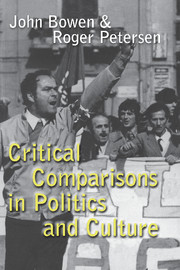Book contents
- Frontmatter
- Contents
- List of Figures
- List of contributors
- Acknowledgments
- 1 Introduction: critical comparisons
- 2 National revivals and violence
- 3 Mechanisms and structures in comparisons
- 4 Comparative methodologies in the analysis of anthropological data
- 5 The role of comparison in the light of the theory of culture
- 6 Case studies of contemporary job loss
- 7 Defining the contours of an Islamic reform movement: an essay in successive contrasts
- 8 Producing an analytic narrative
- 9 Political consciousness on Boa Ventura: 1967 and 1989 compared
- 10 Comparisons in the context of a game theoretic argument
- 11 The role of microhistories in comparative studies
- List of references
- Index of authors
- Subject index
11 - The role of microhistories in comparative studies
Published online by Cambridge University Press: 28 January 2010
- Frontmatter
- Contents
- List of Figures
- List of contributors
- Acknowledgments
- 1 Introduction: critical comparisons
- 2 National revivals and violence
- 3 Mechanisms and structures in comparisons
- 4 Comparative methodologies in the analysis of anthropological data
- 5 The role of comparison in the light of the theory of culture
- 6 Case studies of contemporary job loss
- 7 Defining the contours of an Islamic reform movement: an essay in successive contrasts
- 8 Producing an analytic narrative
- 9 Political consciousness on Boa Ventura: 1967 and 1989 compared
- 10 Comparisons in the context of a game theoretic argument
- 11 The role of microhistories in comparative studies
- List of references
- Index of authors
- Subject index
Summary
All the essays included in this volume involve the use of comparisons, and yet, in my view, their central arguments turn on something other than an inductive “comparative method.” What the arguments do depend on, crucially, is the historical analysis of motives, ideas, and events. They indicate, I believe, a general movement in comparative studies toward theoretically informed, microhistorical accounts of complex social processes.
Not that comparisons are unimportant in these analyses: they play two critical roles. First, the authors use comparisons as ways to generate ideas about the processes and mechanisms underlying particular social phenomena. They then try out these ideas by closely inspecting microhistorical sequences of events. Secondly, the authors give added plausibility to their arguments by tracing such sequences in several different social contexts. Comparisons thus play a role both in generating ideas and theories, and in making the claim that the mechanisms enjoy some degree of generality. The critical test of the theory, however, is in the historical account, the fit between observed sequences of events, on the one hand, and social or cultural models of how events ought to unfold, on the other.
Recall what was entailed in the classical forms of “comparative method,” as delineated, in different ways, by John Stuart Mill and E. B. Tylor. The comparative method followed a logic of induction; it assumed comparability of units across cases; and it aimed to establish synchronic associations among variables. The social scientist began with a small or large number of cases, identified variables, and established relationships among those variables.
- Type
- Chapter
- Information
- Critical Comparisons in Politics and Culture , pp. 230 - 240Publisher: Cambridge University PressPrint publication year: 1999
- 1
- Cited by



